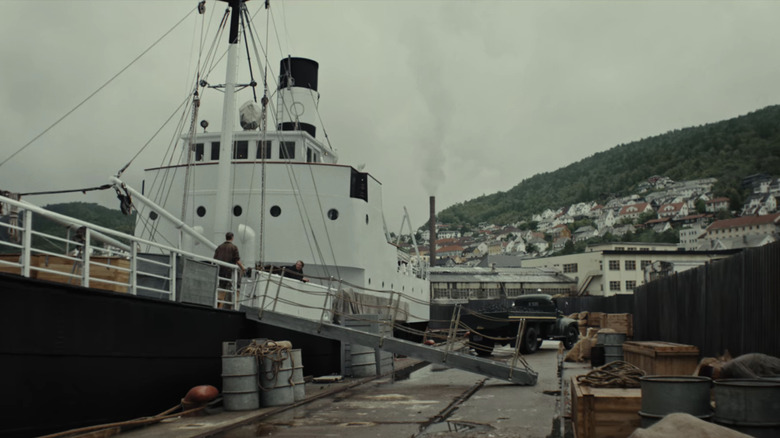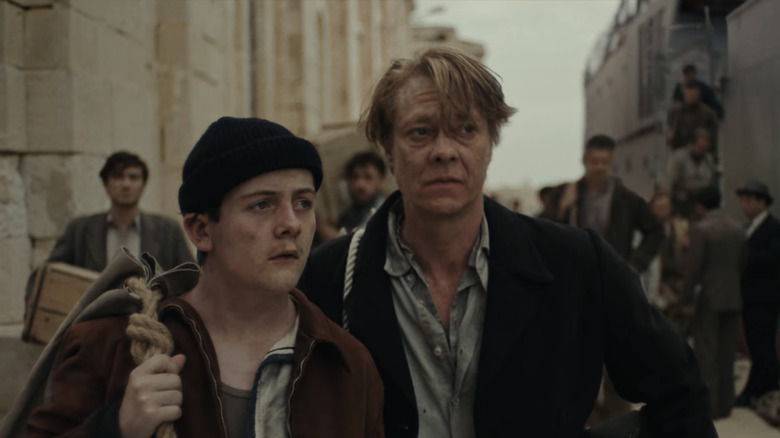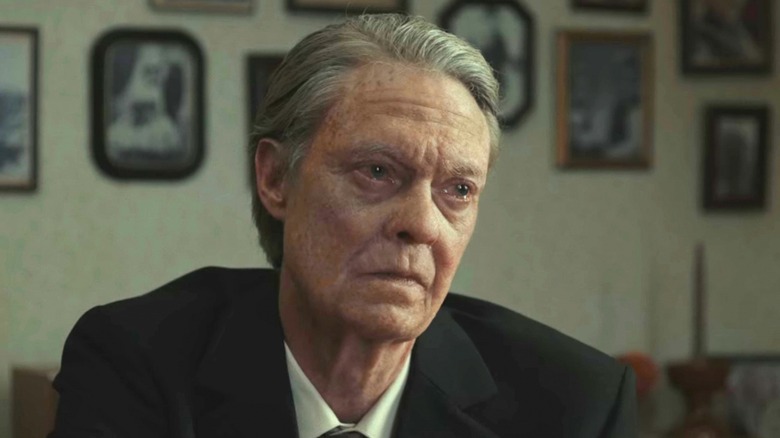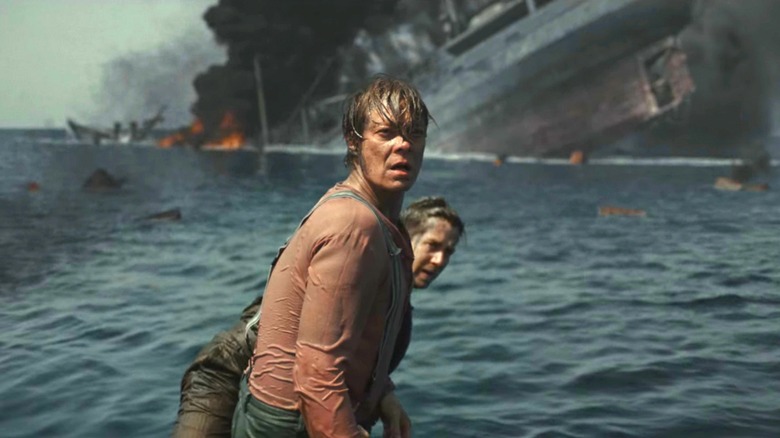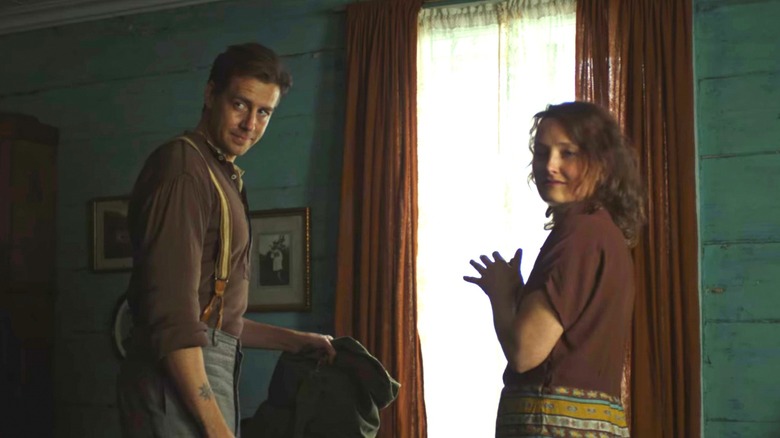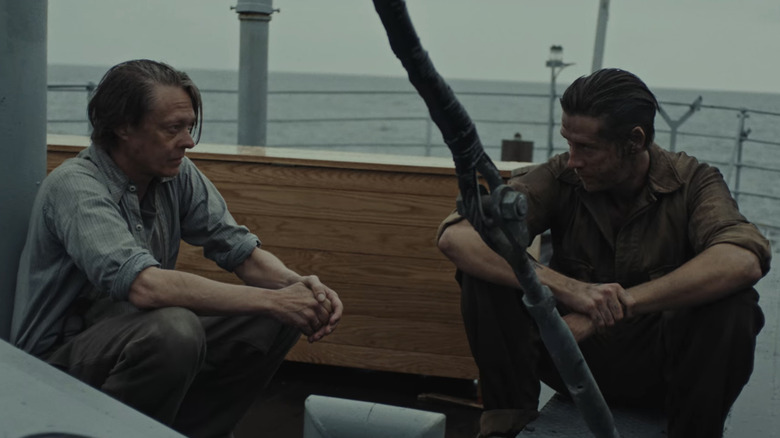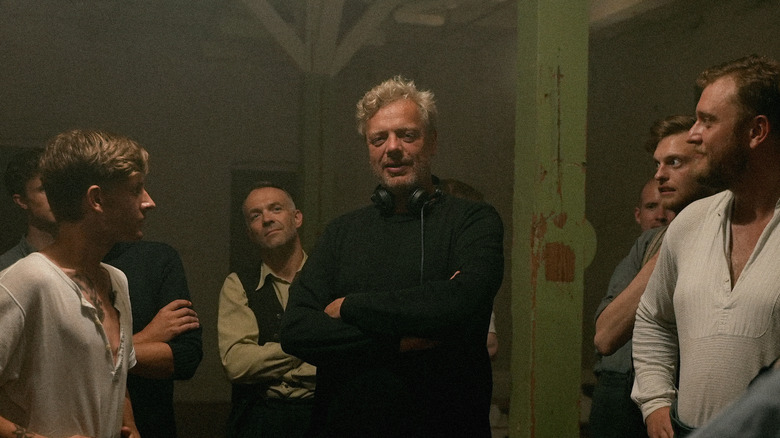The Ending Of War Sailor Explained
Though the victory against the Nazis in the Second World War has been hailed as a major victory in the history of mankind, a tragedy underlies this victory, whereby many of those who risked and sacrificed their lives in this fight never got their recognition, and their traumas had been cast aside by Western society. Such was the case for the sailors in Norwegian merchant ships who were forced to risk their lives during the war transporting cargo that eventually aided the Allies' victory.
The Norwegian war movie "War Sailor" follows two such mariners — Alfred (Kristoffer Joner) and Sigbjørn (Pål Sverre Hagen) — who find themselves having to involuntarily join the Allies' war effort during World War II. The 2022 film, which was the most expensive Norwegian movie produced at a budget of $11 million, was selected as the country's submission to the 95th Academy Awards for consideration as the best international feature film, though it was not nominated. In 2023, "War Sailor" was released as a limited series on Netflix, with 30 minutes of additional footage spread across three hourlong episodes, and reached the platform's Top 10 rankings in its first few days.
While there have been countless movies and TV shows about World War II that follow the perspectives of soldiers of various nationalities, and many of these inarguably tend to be jingoistic, "War Sailor" breaks the mold by displaying the Norwegian experience of the war in all its grim and dispirited reality. In addition to the subtle style of storytelling the film employs, where viewers would often have to read between the lines, "War Sailor" carries some historical context that many viewers around the world may be unaware of. Read on as we explain the ending of "War Sailor" and everything else you need to know about the film.
What you need to remember about Norway during World War II
Officially, Norway remained a neutral country during both World Wars, as the country had very little resources to help the Allied fight. However, diplomatic pressures from the British government compelled Norway to provide their large fleet of ships for cargo transportation, making them the "neutral ally" during World War I.
In the Second World War, after Norway's King Haakon VII refused to bow to Germany's demands of appointing a Nazi sympathizer as the head of Norway's government, the royal family (including Haakon) and the government of Norway fled just before the country was invaded by Germany in 1940. The exiled government established a base in London and founded Nortraship (the Norwegian Shipping and Trade Mission). Nortraship was a way for the exiled government to control the Norwegian fleet of merchant ships outside German territory. These ships were used to transport all sorts of equipment and cargo vital for the Allies' war effort, which marked Norway's significant contribution to the fight against Axis forces.
Meanwhile, the city of Bergen in Norway became an important U-boat base for the Nazi occupation due to its strategically advantageous coastal proximity to Britain. Haakon kept sending radio broadcasts from London to encourage the citizens of Norway to keep fighting for the liberation of the country from Nazi occupation, which did inspire several resistance and civil disobedience movements organized by the Norwegian youth. The German occupation of Norway finally ended with the defeat of Axis forces in 1945, and the royal family returned to the country after five years in exile.
What you need to remember about the plot of War Sailor
In 1939, best friends Alfred and Sigbjørn, struggling to find decent employment, board a merchant ship as sailors, with Alfred having to leave his wife Cecilia (Ine Marie Wilmann) and three children behind in Bergen, Norway. When World War II erupts, Norway makes a deal with Britain to supply their merchant ships for the Allies' war effort, and Alfred, Sigbjørn, and their crew members are forced to stay on the ships and serve in the war without adequate military or safety provisions. If they try to leave, they'll be branded as "deserters" and therefore be disgraced by society and potential employers.
What Alfred assumes would be a banal 18-month maritime affair turns out to be a traumatic six-year period where he and Sigbjørn are faced with the looming possibility of death and danger and witness their fellow sailors perish. Alfred bonds with crew member Aksel (Leon Tobias Slettbakk), a teenage orphan for whom Alfred becomes a father figure. Alfred's protectiveness for Aksel makes him sacrifice a chance at escaping the mandatory war service and reuniting with his family. However, Aksel suffers a grave injury after their ship is torpedoed, forcing Alfred to end Aksel's life out of mercy. Back home, Cecilia receives news of the attack and is led to believe that both Alfred and Sigbjørn are dead.
Alfred and Sigbjørn survive, stranded on a wooden log at sea for several days, after which the two are rescued and rehabilitated at a Canadian hospital. Alfred is told that his family died due to a bombing in Bergen, after which he escapes the hospital in a grief-stricken stupor. In actuality, Cecilia and the children had escaped Bergen the night before the bombings and lived.
What happened at the end of War Sailor?
Sigbjørn finds Cecilia in Askøy, whilst still in touch with embassies around the world in his search for Alfred. Living with Alfred's family, Sigbjørn bonds with the children and develops a romantic relationship with Cecilia. However, Sigbjørn gets news of Alfred's whereabouts, forcing him to forego a possible future with Cecilia. He travels to Singapore to see his former friend having lost himself in a PTSD-induced drug and alcohol binge in a rundown corner of the country. He arranges for Alfred to be sent back home while he heads off for another sailing duty.
However, Alfred's reunion with his wife and children is anything but cathartic. After nine years of enduring their own individual traumas, Alfred and his family now barely recognize each other. Plus, because Alfred fled the hospital in Canada, he finds himself unentitled to the extra pay promised to him by the government for sailing during the war. He faces difficulty finding employment because of his deserter status as well as his physical weakness due to fatigue and age.
Alfred struggles to develop a connection with his youngest child, Olav (Oskar Hallaråker Hellesøy), who was an infant when Alfred left. Olav keeps asking for Sigbjørn, leading Alfred to find out about Cecilia's tryst with Sigbjørn. Alfred eventually loses his temper over Olav, which leads to an argument with Cecilia where he breaks into tears.
Over 20 years later, in 1972, Alfred's family celebrates his 70th birthday, and Sigbjørn shows up to meet his friend after many years. Neither of them has anything to say aside from surface-level chatter, and Sigbjørn leaves as Alfred is shown to still endure the toll of his experiences during the war.
What the end of War Sailor means
Unlike most war dramas that provide heartfelt endings to their tales of heroism and valor, "War Sailor" ends on a much more somber note on the toll any war takes on civilians and their families. Here, Alfred's relationship with his family was a major casualty of the war. Due to Alfred's nine-year absence and presumed death, his wife Cecelia and their children had long moved on from him by the time he reunited with them.
Cecilia had already developed a romantic relationship with Sigbjørn, and her children had learned to live without their father — especially Alfred's youngest child, Olav, who doesn't recognize Alfred given that he was only an infant when Alfred left home. By the film's epilogue in 1972, the disconnect between Alfred and his family doesn't seem to have mended. Alfred and Cecilia are together merely out of marital obligation, Alfred shares no bond with his grandson, his two sons are away from home (with a long-running disconnect with Olav heavily hinted at), and he has no emotion about celebrating his 70th birthday or meeting Sigbjørn after several years.
Toward the end of "War Sailor," Alfred shows symptoms indicative of not just post-traumatic stress disorder, but also of the "War Sailor syndrome", a term coined for the physical and mental ailments that Norwegian sailors faced after the war. Symptoms of the "War Sailor syndrome" include difficulties adapting to civilian life, nightmares, depression, and insomnia — all of which are apparent in Alfred's behavior and actions as a result of his wartime experiences.
If you or someone you know needs help with mental health, please contact the Crisis Text Line by texting HOME to 741741, call the National Alliance on Mental Illness helpline at 1-800-950-NAMI (6264), or visit the National Institute of Mental Health website.
What happened to the war sailors after the war?
The text at the end of "War Sailor" details the number of Norwegian merchant ships and their sailors that had gone missing during the war and how their involvement in the war was instrumental in Britain's victory. However, these sailors weren't recognized for their efforts the same way as those in the army were, and they were often left to fend for themselves without adequate post-war provisions and benefits that veterans could claim. What adds salt to the wound is that it was because of these sailors that the government of Norway, even in exile, continued receiving enough funds to continue operations, even more so than other countries during the war. By the end of the war, Nortraship reported a profit of 550 million Norwegian kroner — over $1.2 billion in today's money.
Despite this, war sailors earned lesser pensions than soldiers, and there were even suggestions within the Parliament that these sailors shouldn't be entitled to any war pension. These sailors and their widowed families had to put up a fight for the next few decades to earn their recognition and remuneration — having to prove that the difficulties they faced were directly caused by the war. It wasn't until 1968 — 23 years after the war ended — that the burden of proof fell onto the authorities to prove that there wasn't any relation between the war and the physical, mental, and economic predicaments of the sailors.
This shameful neglect on behalf of the government caused a looming sense of resentment among the citizens of Norway for several subsequent decades, and the neglect was only acknowledged in 2013 through an apology issued by then-defense minister Anne Grethe Strøm-Erichsen.
What the ending means for Cecilia and Sigbjørn's relationship
With the love that Alfred, Cecilia, and their children are shown to have for each other before Alfred leaves to sail, it's devastating to see how their individual experiences enduring the trauma of the war created a gap between Alfred and his family — a gap that is shown to plague him even at old age. When Sigbjørn lives with Cecilia and her children for a few days, the two find comfort in each other. Even the children warm up to having Sigbjørn as a father figure in Alfred's absence, especially Olav, who later struggles to bond with Alfred, his biological father, after Sigbjørn leaves.
Just when it seemed that Sigbjørn could adopt Alfred's family as his own, he gets a sobering reminder about Alfred still being alive after receiving news of him being in Singapore. Sigbjørn can't live with blissful ignorance that his best friend — whose family he's living with — is still out there in need of help. He chooses not to go back to Alfred's house after rescuing him, given that it would only make matters more complicated.
In the 1972 epilogue, when Cecilia meets Sigbjørn for the first time in many years, there are hints of her still having some residual feelings for him, over 20 years after their brief affair. There's a glimmer in her demeanor that presumably was missing in her years with Alfred, though she restricts herself and pretends as though their tryst never happened. Cecilia and Sigbjørn still may harbor feelings for the other, given that the two pause to catch glimpses of each other through the translucent doors between them before Sigbjørn leaves, ending their ill-fated romance for good.
What the ending means for Alfred and Sigbjørn's friendship
The friendship between Alfred and Sigbjørn is at the core of "War Sailor." The film is filled with moments of immense care between the two friends who stick together through thick and thin and endure great hardships to protect and comfort each other, even at the risk of their own lives.
However, one of the many tragedies of "War Sailor" is that Alfred and Sigbjørn's friendship falls victim to the complexities of the aftermath of their experiences in the war. Their friendship gets damaged beyond repair long after they bid their goodbyes in Singapore, when Alfred finds out about Sigbjørn and Cecilia's affair during his absence. It's possible that, in the subsequent years, Alfred held some resentment over the fact that he himself could never connect with his family in the same way that Sigbjørn did in just a few days.
It's also imaginable that Sigbjørn too carried the guilt of sharing the bed with Cecilia while knowing that Alfred was still alive and suffering elsewhere — a guilt that ultimately drove him away from his former friend for many years to come. In the 1972 epilogue, it's revealed that the two hadn't met again after Sigbjørn saw Alfred off in Singapore. When they sit together after years, there's a wide observable gap between them — one fraught with trauma, tension, and age — a gap too wide to mend in the little time the two men have left.
What has director Gunnar Vikene said about the ending?
The ending of "War Sailor" makes it unmistakably clear what Norwegian sailors like Alfred had lost during and after the Second World War. For the film's writer-director Gunnar Vikene, the genesis of the entire film was from its ending, as witnessing the condition of aged war sailors in the years after the war was what drove the director to dig deeper into their pasts.
In an interview with Golden Globes, Vikene revealed that an experience he had with an intoxicated war sailor when he was 13 years old had cultivated a curiosity in him to know more about the lives of these war sailors and their experiences during World War II. This curiosity stayed with him until he collected enough stories of such sailors to finally write "War Sailor." That's why, as Vikene revealed, he wrote the last scene of the film first, "because in that scene is the emotional key to me. ... I could emotionally understand everything in that film after I wrote that scene, even though I have never been to war. To me, the last scene reflects on the sadness over everything that could have been but never was."
Vikene emphasized his disappointment at how the sailors were never recognized for their sacrifices. "They were never mentioned in relation to the war. They did not fit into the idea of the war hero. They did not have uniforms or guns or medals or anything. But at the same time, no one meant more for the result. Without them, the Allies would have lost the war. Period. There is no historian who does not agree with that."

